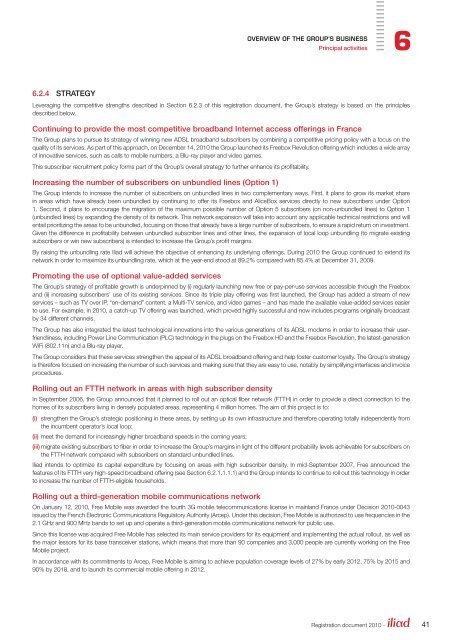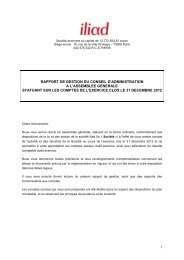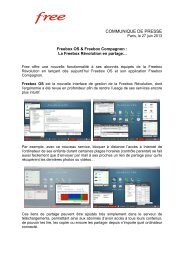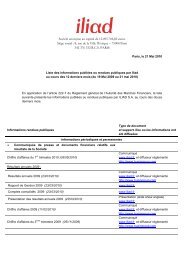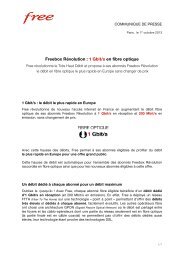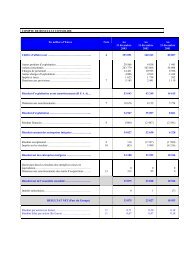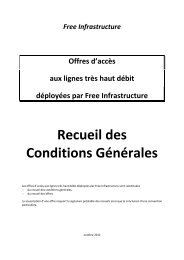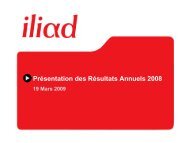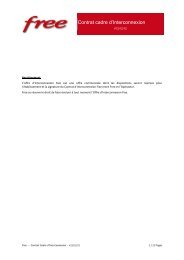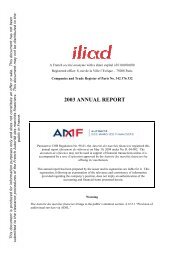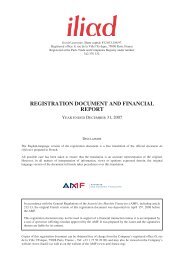2010 REGISTRATION DOCUMENT - Iliad
2010 REGISTRATION DOCUMENT - Iliad
2010 REGISTRATION DOCUMENT - Iliad
You also want an ePaper? Increase the reach of your titles
YUMPU automatically turns print PDFs into web optimized ePapers that Google loves.
OVERVIEW OF THE GROUP’S BUSINESS<br />
Principal activities 6<br />
6.2.4 STRATEGY<br />
Leveraging the competitive strengths described in Section 6.2.3 of this registration document, the Group’s strategy is based on the principles<br />
described below.<br />
Continuing to provide the most competitive broadband Internet access offerings in France<br />
The Group plans to pursue its strategy of winning new ADSL broadband subscribers by combining a competitive pricing policy with a focus on the<br />
quality of its services. As part of this approach, on December 14, <strong>2010</strong> the Group launched its Freebox Revolution offering which includes a wide array<br />
of innovative services, such as calls to mobile numbers, a Blu-ray player and video games.<br />
This subscriber recruitment policy forms part of the Group’s overall strategy to further enhance its profi tability.<br />
Increasing the number of subscribers on unbundled lines (Option 1)<br />
The Group intends to increase the number of subscribers on unbundled lines in two complementary ways. First, it plans to grow its market share<br />
in areas which have already been unbundled by continuing to offer its Freebox and AliceBox services directly to new subscribers under Option<br />
1. Second, it plans to encourage the migration of the maximum possible number of Option 5 subscribers (on non-unbundled lines) to Option 1<br />
(unbundled lines) by expanding the density of its network. This network expansion will take into account any applicable technical restrictions and will<br />
entail prioritizing the areas to be unbundled, focusing on those that already have a large number of subscribers, to ensure a rapid return on investment.<br />
Given the difference in profi tability between unbundled subscriber lines and other lines, the expansion of local loop unbundling (to migrate existing<br />
subscribers or win new subscribers) is intended to increase the Group’s profi t margins.<br />
By raising the unbundling rate <strong>Iliad</strong> will achieve the objective of enhancing its underlying offerings. During <strong>2010</strong> the Group continued to extend its<br />
network in order to maximize its unbundling rate, which at the year-end stood at 89.2% compared with 85.4% at December 31, 2009.<br />
Promoting the use of optional value-added services<br />
The Group’s strategy of profi table growth is underpinned by (i) regularly launching new free or pay-per-use services accessible through the Freebox<br />
and (ii) increasing subscribers’ use of its existing services. Since its triple play offering was fi rst launched, the Group has added a stream of new<br />
services – such as TV over IP, “on-demand” content, a Multi-TV service, and video games – and has made the available value-added services easier<br />
to use. For example, in <strong>2010</strong>, a catch-up TV offering was launched, which proved highly successful and now includes programs originally broadcast<br />
by 34 different channels.<br />
The Group has also integrated the latest technological innovations into the various generations of its ADSL modems in order to increase their userfriendliness,<br />
including Power Line Communication (PLC) technology in the plugs on the Freebox HD and the Freebox Revolution, the latest-generation<br />
WiFi (802.11n) and a Blu-ray player.<br />
The Group considers that these services strengthen the appeal of its ADSL broadband offering and help foster customer loyalty. The Group’s strategy<br />
is therefore focused on increasing the number of such services and making sure that they are easy to use, notably by simplifying interfaces and invoice<br />
procedures.<br />
Rolling out an FTTH network in areas with high subscriber density<br />
In September 2006, the Group announced that it planned to roll out an optical fi ber network (FTTH) in order to provide a direct connection to the<br />
homes of its subscribers living in densely populated areas, representing 4 million homes. The aim of this project is to:<br />
(i) strengthen the Group’s strategic positioning in these areas, by setting up its own infrastructure and therefore operating totally independently from<br />
the incumbent operator’s local loop;<br />
(ii) meet the demand for increasingly higher broadband speeds in the coming years;<br />
(iii) migrate existing subscribers to fi ber in order to increase the Group’s margins in light of the different probability levels achievable for subscribers on<br />
the FTTH network compared with subscribers on standard unbundled lines.<br />
<strong>Iliad</strong> intends to optimize its capital expenditure by focusing on areas with high subscriber density. In mid-September 2007, Free announced the<br />
features of its FTTH very high-speed broadband offering (see Section 6.2.1.1.1.1) and the Group intends to continue to roll out this technology in order<br />
to increase the number of FTTH-eligible households.<br />
Rolling out a third-generation mobile communications network<br />
On January 12, <strong>2010</strong>, Free Mobile was awarded the fourth 3G mobile telecommunications license in mainland France under Decision <strong>2010</strong>-0043<br />
issued by the French Electronic Communications Regulatory Authority (Arcep). Under this decision, Free Mobile is authorized to use frequencies in the<br />
2.1 GHz and 900 MHz bands to set up and operate a third-generation mobile communications network for public use.<br />
Since this license was acquired Free Mobile has selected its main service providers for its equipment and implementing the actual rollout, as well as<br />
the major lessors for its base transceiver stations, which means that more than 90 companies and 3,000 people are currently working on the Free<br />
Mobile project.<br />
In accordance with its commitments to Arcep, Free Mobile is aiming to achieve population coverage levels of 27% by early 2012, 75% by 2015 and<br />
90% by 2018, and to launch its commercial mobile offering in 2012.<br />
Registration document <strong>2010</strong> - 41


